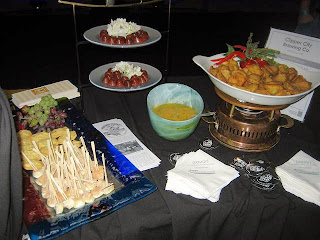 It's Mild in May in the UK. That is, Mild Ale.
It's Mild in May in the UK. That is, Mild Ale.
But exactly what is Mild Ale -- and what is "traditional" mild ale-- may depend upon which year one chooses for the basis of the "tradition".
First, a definition of modern Mild Ale, and of the May campaign:
CAMRA, the Campaign for Real Ale, and a number of pubs and breweries, will be celebrating the beer style Mild in May with a variety of different events to raise the awareness of this endangered beer style.
Mild is one of the most traditional beer styles, and whilst it is enjoying a small revival in today's real ale market, it still only accounts for an estimated 3-5% of all real ale sales. Mild has perhaps been overshadowed in recent years by more fashionable beers such as golden ales and premium bitters.
Mild beers tend not to be very strong and have an ABV in the 3% to 3.5 % range. They are usually dark in colour, due to the use of well-roasted malts or barley, and are often less hopped than bitters, having a chocolatey character with nutty burnt flavours.
In the US, the
Beer Judge Certification Program defines Mild as:
Appearance: Copper to dark brown or mahogany color. A few paler examples (medium amber to light brown) exist. Generally clear, although is traditionally unfiltered. Low to moderate off-white to tan head. Retention may be poor due to low carbonation, adjunct use and low gravity.
Flavor: Generally a malty beer, although may have a very wide range of malt- and yeast-based flavors (e.g., malty, sweet, caramel, toffee, toast, nutty, chocolate, coffee, roast, vinous, fruit, licorice, molasses, plum, raisin). Can finish sweet or dry. Versions with darker malts may have a dry, roasted finish. Low to moderate bitterness, enough to provide some balance but not enough to overpower the malt. Fruity esters moderate to none. Diacetyl and hop flavor low to none.
Mouthfeel: Light to medium body. Generally low to medium-low carbonation. Roast-based versions may have a light astringency. Sweeter versions may seem to have a rather full mouthfeel for the gravity.
Overall Impression: A light-flavored, malt-accented beer that is readily suited to drinking in quantity. Refreshing, yet flavorful. Some versions may seem like lower gravity brown porters.
Comments: Most are low-gravity session beers in the range 3.1-3.8%, although some versions may be made in the stronger (4%+) range for export, festivals, seasonal and/or special occasions. Generally served on cask; session-strength bottled versions don’t often travel well.
But now read this from UK blogger
Ron Pattinson:
Both Beer and Ale were brewed to a variety of strengths from a variety of base malts. So you had Pale Ale, Amber Ale and Brown Ale; Pale Beer, Amber Beer and Brown Beer. These could be made to many strengths, Common being standard strength, Stout the strongest. Only Beer was usually made at the weakest strengths: Table Beer or Small Beer.
A further method of classifying malt liquors was their age. Ones sold young were described as Mild. Ones that had been aged were called Keeping or Stale. Most (but not all Ales) were sold "mild", but some beers were, too. Porter is a good example of a Brown Beer that was often sold "mild" from the 1700's right up until its demise in the 1940's. The big London brewers all made Mild Porter and Keeping Porter, which were often mixed before sale.
You can see that in the 1700's Mild Ale was a very vague term. It covered Ales of all colours and all strengths. It wasn't as much as style as a description of the level of conditioning. [emphasis mine] None of the beers described as Mild Ale at this time has any but the slightest similarity with modern Mild. Even the weakest would have had an OG of at least 1050º. Mild Brown Ale, brewed from 100% brown malt must have had the roasty flavour of London Porter, just with a much lower level of hopping.
Ron has interesting things to say about stouts as well, backed up by his research. It's good reading.
With all the bigger, hoppier beers here in the US these days, it's difficult to find a well-made Mild, of whatever year's tradition.
The BJCP's comment on the modern version— "generally served on cask; session-strength bottled versions don’t often travel well." — is well taken. Witness mild's victory at the 2007
Great British Beer Festival over many stronger beers.
 For straight talk on wine, among other sources, I go to Fredric Koeppel at Bigger than My Head. He recently blogged about his first -- and second-- rosé of the season.
For straight talk on wine, among other sources, I go to Fredric Koeppel at Bigger than My Head. He recently blogged about his first -- and second-- rosé of the season.









.png)





